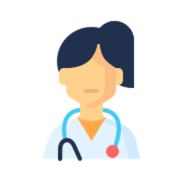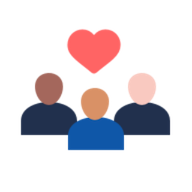
Powered By





 Continue with Facebook
Sign up with your email
Continue with Facebook
Sign up with your email
Polycystic ovary syndrome (PCOS) symptoms usually start around puberty, but many women aren’t diagnosed with PCOS until their 20s or 30s, often when they try to get pregnant.
PCOS symptoms are caused by hormone imbalances. These include insulin resistance and higher levels of androgens, sometimes called “male hormones,” which women normally have only in small amounts. Because PCOS symptoms can be misinterpreted or ignored, women may go months or years without a diagnosis.
Not everyone with PCOS will have all the same symptoms. Still, here are eight of the most common symptoms PCOS can cause:
One of the most common signs of PCOS is abnormal menstrual cycles. Between 75 percent and 85 percent of women with PCOS have missed or irregular periods as a result.
In a typical menstrual cycle, follicles (fluid-filled sacs) develop in the ovaries and release an egg. This happens during a phase of the menstrual cycle called ovulation. PCOS can affect this process or stop it from happening. This can lead to irregular periods and unpredictable ovulation.
Because of the higher levels of androgens involved in PCOS, many small, undeveloped follicles can build up in the ovaries. This is where the term “polycystic ovaries” comes from. Because of their small size and the immature eggs they contain, the follicles don’t release eggs regularly. As a result, hormone levels in the body become unbalanced.
PCOS may lead to a range of menstrual disorders, including:
PCOS is one of the most common causes of infertility, but it’s treatable. About half of women with PCOS have trouble getting pregnant without medical help. Infertility in PCOS is directly linked to missing or irregular ovulation, though other factors can also play a role.
In many cases of PCOS, weight loss can dramatically improve the chances of getting pregnant. This is because weight management helps to regulate your hormones, reduce insulin resistance, and increase ovulation. In one study, women with PCOS and a body mass index (BMI) of 40 who lost 10 percent of their body weight had a 68 percent higher chance of getting pregnant.
Fertility treatments such as ovulation-stimulating medications or in vitro fertilization (IVF) can also help if you have trouble getting pregnant with PCOS.
Up to 70 percent of women with PCOS have hirsutism, or excess hair growth on the face or body. Hirsutism is one of the most common and noticeable symptoms of PCOS. This is caused by high levels of androgen hormones. Hirsutism can cause dark, thick, or coarse hair growth in areas where women don’t usually have a lot of body or facial hair, such as:
PCOS can change the hair growth pattern on your scalp too. About 1 in 5 women with PCOS experience male-pattern baldness, also called androgenic alopecia. This is another effect of high androgen levels. Seen more often in men, male-pattern baldness can look like thinning hair on your crown or temples, or like a receding hairline. PCOS-related hair loss often becomes more noticeable in middle age.
If you’re concerned about losing your hair with PCOS, talk to your doctor. They might recommend medications for hair loss or a hair transplant to treat male-pattern baldness.
Hyperandrogenism (high androgen levels) in PCOS can cause your skin to produce more sebum (oil), which can lead to adult acne. Studies show that about 30 percent to 40 percent of women with PCOS have adult acne compared with about 17 percent of women without PCOS.
Acne associated with hyperandrogenism often looks different from acne caused by other factors. It tends to be deeper, more severe, and slower to clear up. Acne from PCOS tends to get worse around your menstrual period and most often appears on the chin and jaw.
Your healthcare provider or dermatologist may recommend oral contraceptives (birth control pills) or other medications to reduce acne from PCOS.
Some women with PCOS also develop hidradenitis suppurativa (HS), though the exact connection is not fully understood. HS is more common in people with sex hormone imbalances, including high androgens.
HS, also called acne inversa, is a painful, long-term skin condition. It causes lumps and tunnels to form under the skin, often in areas with sweat glands.
Research shows that people with HS are more than twice as likely to also have PCOS compared with those who don’t have HS.
Acne and acne inversa aren’t the only common skin symptoms of PCOS. Some people develop acanthosis nigricans, a type of skin darkening that often appears in areas where the skin folds, such as the armpits, groin, or under the breasts. The darkened skin usually has a velvety texture.
Acanthosis nigricans is a sign of insulin resistance, which may play a role in PCOS. Insulin is a hormone made by the pancreas that helps cells use sugar in the blood for energy. When your body doesn’t use insulin properly, insulin levels rise. This can cause the ovaries to make more androgens. Scientists believe high insulin can also overstimulate skin cells, leading to acanthosis nigricans.
In a study on skin symptoms of PCOS in JAMA Dermatology, almost 40 percent of participants with PCOS had acanthosis nigricans.
PCOS can raise the risk of mood swings and mental health conditions. Women with PCOS are at an increased risk for depression and anxiety compared to women without PCOS. Their risk for depression is around four times higher than the average, and their risk for anxiety is around six times higher.
Hormone imbalances may play a part, but living with the symptoms of PCOS can also affect emotional well-being. For example, symptoms like hirsutism and hair loss may affect self-esteem. Infertility, whether related to PCOS or not, can also lead to anxiety, depression, and emotional distress.
If you notice mood changes or any mental health symptoms, it’s important to talk to your doctor. They can help you find healthy coping mechanisms and treatment options.
Between 40 percent and 80 percent of all women with PCOS live with obesity or have trouble with weight management. While weight loss can be challenging, even a small amount — such as 5 to 10 pounds — may help regulate your menstrual cycle.
Maintaining a healthy weight for your body can also have a positive effect on how your body uses insulin and reduce the risk of PCOS complications such as heart disease, type 2 diabetes, and infertility. Weight loss may also improve other PCOS symptoms, such as acne and unwanted hair growth.
Lifestyle changes like a balanced diet and regular exercise are usually the most effective ways to reach and stay at a weight that’s healthy for you. Your healthcare provider can guide you in making these changes. In some cases, they may also recommend weight-loss medicines. Weight loss through surgery may also be an option for women who are not able to lose weight through lifestyle changes or weight-loss medications.
On MyPCOSteam, people share their experiences with PCOS, get advice, and find support from others who understand.
Which PCOS symptoms have you experienced? Let others know in the comments below.
Get updates directly to your inbox.



 Continue with Facebook
Sign up with your email
Continue with Facebook
Sign up with your email
Become a member to get even more




A myPCOSteam Member
has anyone heard of pcos moon face? i mean this one https://www.aspect-health.com/blog/what-is-moon...
i don't know if i'm the only one here thinkinf of it :-(
We'd love to hear from you! Please share your name and email to post and read comments.
You'll also get the latest articles directly to your inbox.